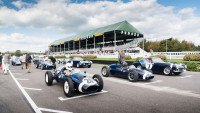The history of Goodwood and the Goodwood Revival
17th April 2017

The Goodwood Circuit is revered around the world as one of the most historic motorsport venues for racing on two and four wheels.
An ex-military airfield, from 1948 until the mid-60s Goodwood was the spiritual home of British motor racing; home to unforgettable classic sports car races including the Tourist Trophy and the Glover Trophy – a non-championship F1 Grand Prix race.
These race meetings would entice the world’s best motor racing drivers, from Graham Hill and Mike Hawthorn through to Jim Clark and Stirling Moss. In fact, it was Goodwood’s St. Mary’s Corner where Moss’ motor racing career came to an end following a nasty accident in 1962.
As the years rolled by, motor racing continued to evolve and circuits had to change with the times too. But the circuit was forced to close its doors in 1966 after the track’s owners refused to amend the course with chicanes to cope with the increasing power of modern day race cars.
Though Goodwood Circuit remained in use after closing its doors, as a testing and track day venue, it was out of the contemporary motor racing calendar for more than 30 years before the decision was taken to reopen the track in 1998 – entirely in its original form.
It took six years of magical restoration in the backdrop of the Sussex Downs for Goodwood Circuit to return to its former glories. The inspiration behind its renovation was the Goodwood Revival – a three-day annual festival hosted in September for all manner of motorcycle and road racing cars that would have taken to the circuit in its original heyday (1948-1966).
The inaugural Goodwood Revival was opened by the Earl of March in the very same Bristol 400 that his grandfather had driven around Goodwood 50 years ago.
It has since become one of the world’s most unique motor race meetings, where fans turn up in their droves – in period dress – to soak in the sights and sounds of the best Grand Prix cars from the 50s and 60s. No modern vehicles are allowed and the festival acts as the ideal excuse for classic car fans to showcase their vintage vehicles, complete with cherished number plates or private number plates that complete the look.
Lord March was also integral in the foundation of the Goodwood Festival of Speed in 1993, as he sought to bring modern day motor racing back to the Goodwood estate.
Without the required permit to host an official race, Lord March instead opted to host a meeting within his own grounds, using the famous hill climb as the focal point for the festival’s features and attractions.
The atmosphere at the Festival of Speed really is something to behold. Motor racing fans can walk around the paddocks and get up close and personal with the cars and the drivers themselves. From F1 demonstrations to Soapbox challenges, more than 100,000 people make the yearly pilgrimage to Goodwood, and although it is never likely to host a Formula One Championship race in the future, there is something truly special about the circuit and the estate as a whole – you can literally smell the history!

